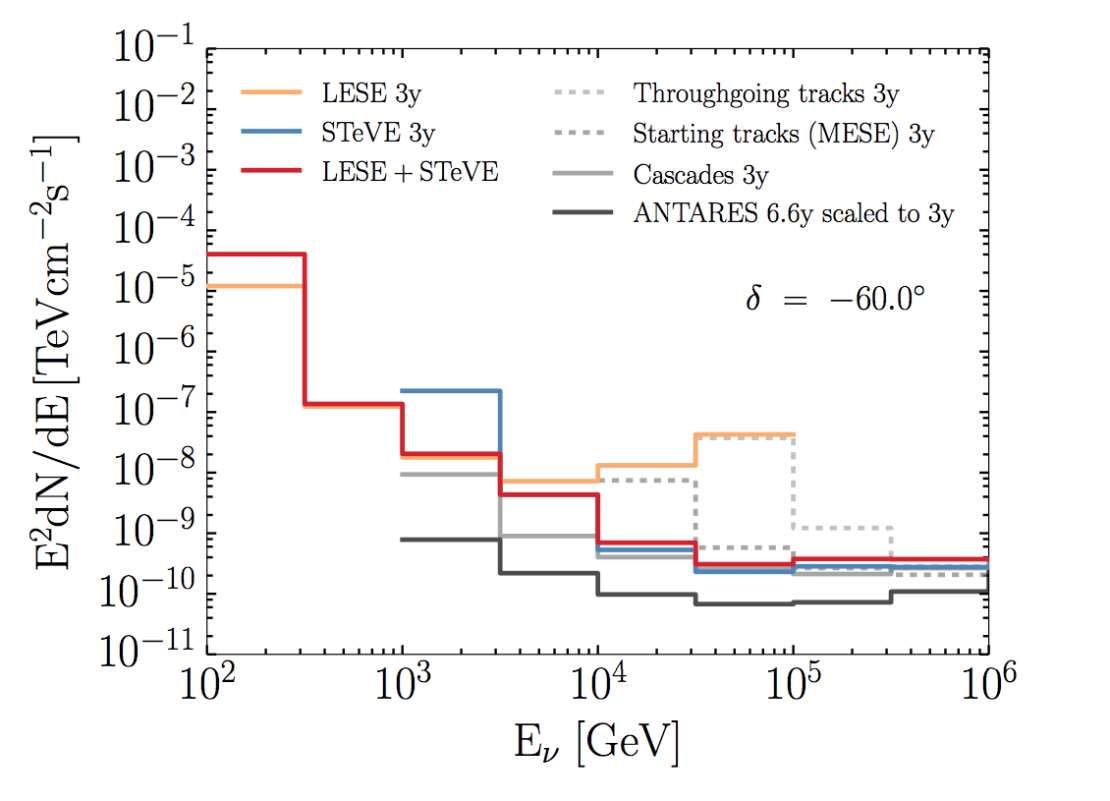The search for sources of high-energy neutrinos and cosmic rays has revealed neutrinos from distant galaxies and from all over the sky traveling through the Antarctic ice. Closer sources, though, those that could produce neutrino emission in the Milky Way, have been more elusive.
In IceCube, the signature of sources such as galactic supernova remnants peaks at low energies, well below 100 TeV, where the large background of atmospheric muons is difficult to filter out. The bulk of galactic neutrino emission is expected in the southern sky, where the Earth cannot serve as a natural filter to remove the million-to-one muon-neutrino signal. In a recent paper by the IceCube Collaboration, two new techniques improve searches at energies from 100 TeV down to 100 GeV. When tested with a few years of IceCube data, these new selections improve the sensitivity and discovery potential, allowing for the first time the search for galactic point-like sources using track events created by muon neutrinos that in many cases are indistinguishable from atmospheric muon tracks. These results have just been submitted to the journal Astroparticle Physics.

Scientists have speculated that at high energies neutrino emission should be associated with gamma-ray emission, since the highest energy gamma rays could be produced in the same mechanisms that produce the highest energy neutrinos. However, gamma rays can also be produced in environments where neutrino emission would be disfavored.
The gamma-ray galactic sky shows a large concentration of sources in the Southern Hemisphere, where both the galactic center and the majority of the galactic plane are seen from Earth. This is, thus, a region worth exploring with IceCube to look for potential neutrino emission from the same sources that produce the gamma rays.
However, the most successful searches for high-energy neutrinos select particle interactions that start in the detector—both cascade- and track-like events—or track-like events that come from the northern sky. Track-like events are those that provide a good pointing resolution, which on average is well below 1 degree.
In previous searches for astrophysical neutrinos using events with the interaction vertex within the detector, a fairly high energy cut was also applied to obtain an efficient selection. The concern is that the majority of galactic neutrino emission could happen at lower energies and, thus, might be removed with this cut. To lower this energy threshold and still preserve a good pointing resolution in the southern sky, researchers have looked closer at track events in IceCube.
In a new technique dubbed STeVE, for “starting TeV events,” the selection focuses on neutrino events between 10 and 100 TeV and uses techniques developed in a previous IceCube analysis (link to MESE news 414) to remove the background of multiple parallel atmospheric muon events, which has proved to be a resistant background at low energies. In addition, this event selection strategy exploits the difference in the observed photon pattern of bundles of low-energy atmospheric muons compared to individual high-energy muons.
In a second technique, called LESE, for low-energy starting events, the selection was optimized for neutrinos below 10 TeV. At low energies and due to the small granularity of the IceCube detector, with strings of sensors deployed at horizontal distances of 125 meters, it’s easier for muon tracks to enter the detector without significant energy deposition detected by the outer layers of sensors, which mimics a muon neutrino interacting within the detector volume. LESE aims at selecting track-like events with energies as low as 100 GeV, leveraging the experience gained with veto-based selection techniques in searches for dark matter.
Both of these techniques introduce a new online event selection filter that selects starting events based on an initial fast reconstruction. This new filter is the first to accept starting events from the entire southern sky while maintaining as large as possible active detector volume.
STeVE and LESE where tested with 3 and 4 years of IceCube data, respectively, in a search for sources of astrophysical neutrinos anywhere in the southern sky and for neutrino emission from the direction of 96 known gamma-ray sources. No significant excess of neutrino emission was found, but the techniques have proven to be sensitive to strong galactic sources of low-energy astrophysical neutrinos.
“Studying starting events from the southern sky at these energies poses many new challenges,” explains Rickard Ström, a main analyzer who worked on this study as a PhD candidate at Uppsala University. “We leveraged expertise from previous searches for point sources and exotic signatures such as dark matter. This was the first time IceCube was able to study point sources in the southern sky at these energies and using tracks with degree precision,” adds Ström.
Searches combining both techniques result in an effective area comparable to ANTARES, which thanks to its location in the Mediterranean Sea has a priori a better neutrino view of our galaxy. STeVE and LESE selections reduce the muon background to a few thousand events per year and significantly improve IceCube’s sensitive and discovery potential of point-like sources in the southern sky with neutrinos with energies below 100 TeV.
info “Neutrinos below 100 TeV from the southern sky employing refined veto
techniques to IceCube data,” IceCube Collaboration: M. G. Aartsen et al., Astroparticle Physics, Volume 116, 2020, 102392, sciencedirect.com, arxiv.org/abs/1902.05792